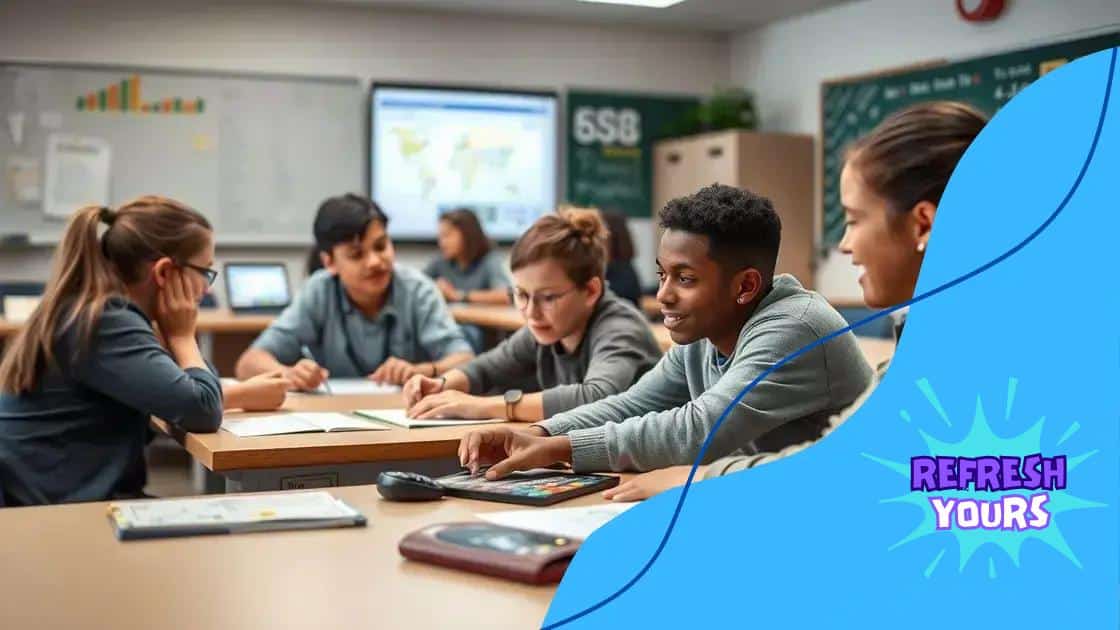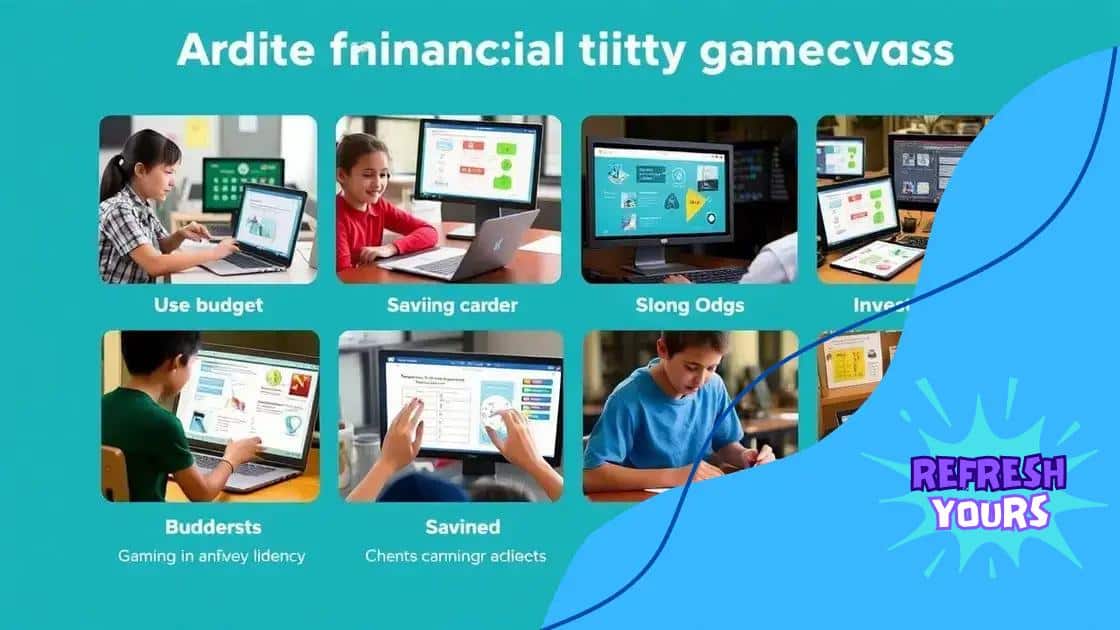The role of gamification in teaching financial literacy

The role of gamification in teaching financial literacy enhances student engagement and retention by using game-like elements to make learning about money management enjoyable and effective.
The role of gamification in teaching financial literacy is changing how we engage learners. Have you ever tried to teach a financial concept using a game? It’s fascinating how play can make complex ideas easier to grasp!
Understanding gamification and its principles
Understanding gamification is essential for effectively teaching financial literacy. It combines game-like elements in non-game contexts, making learning more engaging and enjoyable. By incorporating these principles, educators can enhance students’ experiences and improve retention of financial concepts.
Key Principles of Gamification
To grasp the concept of gamification, one must know its core principles:
- Achievement: Recognizing progress through rewards boosts motivation.
- Engagement: Active participation keeps learners interested and focused.
- Feedback: Immediate responses allow students to adjust their understanding and approach.
- Challenge: Offering progressively difficult tasks encourages critical thinking and problem-solving.
Each principle serves a unique function in the educational process. For instance, when students receive rewards for completing tasks, they feel accomplished and eager to learn more. This is especially true in the realm of personal finance, where practical application is crucial. Gamification turns dry content into interactive experiences.
How Gamification Works
To effectively implement gamification in teaching financial literacy, it’s vital to create a context where students can practice their skills. This could involve simulations, point scoring systems, or competitions. For example, imagine students playing a virtual market simulation where they make investment decisions based on real-world data. They would be actively involved in learning how to manage finances while competing against each other, thus enhancing their understanding.
As students engage with gamified financial literacy tools, they develop crucial life skills. These include budgeting, saving, and making informed financial decisions. Moreover, the fun and competitive nature of gaming reduces anxiety associated with learning difficult subjects.
In summary, effectively leveraging gamification involves understanding its key principles and applying them in ways that resonate with students. It’s about creating a learning environment that feels safe and enjoyable, allowing for mistakes and growth without fear. With the right focus, gamification can be a game changer in teaching financial literacy.
Benefits of gamification in financial education
Benefits of gamification in financial education are numerous and impactful, turning traditional learning into an engaging experience. This approach not only holds attention but also fosters a deeper understanding of financial concepts.
Enhancing Engagement
One of the primary benefits is the increase in student engagement. Gamification turns mundane topics into interactive activities. When students participate in game-like challenges, they are more likely to stay focused and motivated. This heightened engagement leads to better retention of crucial financial principles.
Improving Learning Outcomes
By incorporating elements of competition and achievement, gamified learning can result in improved learning outcomes. Students are encouraged to compete against themselves or their peers, making learning exciting. For instance, using point systems and rewards for completing tasks can significantly motivate students to delve deeper into financial concepts.
- Active Participation: Games require active involvement, leading to better comprehension.
- Instant Feedback: Players receive immediate responses to their actions, helping them learn from mistakes.
- Skill Development: Gamified activities promote critical thinking and decision-making skills.
- Fun and Enjoyable Learning: Adding game mechanics transforms the learning experience to be enjoyable.
Moreover, immersing students in realistic financial scenarios through gamification allows them to understand the consequences of their financial choices. A simulation where students manage a budget can illustrate the importance of making informed decisions. When they see the impact of their choices in a safe environment, they are more likely to apply these lessons in real life.
In summary, the advantages of gamification include elevated engagement, improved results, and real-world application of financial knowledge. By adopting these strategies, educators can create a dynamic learning atmosphere that makes financial literacy not just understandable, but also enjoyable.
Examples of gamified financial literacy programs

There are many examples of gamified financial literacy programs that successfully engage students and teach essential skills. These programs integrate play elements into financial education, making learning fun and effective.
Popular Gamified Programs
Several educational organizations have developed programs that use gamification to teach financial concepts. Each program employs different strategies to enhance student participation and understanding. Below are some noteworthy examples:
- Greenlight: A debit card for kids that includes an app to help parents teach their children about saving, spending, and investing.
- Bankaroo: A virtual bank for kids that teaches money management through planning and budgeting exercises.
- Gen i Revolution: An interactive game where users navigate challenges and make financial decisions in a simulated economy.
- Smarty Pig: An online savings tool that gamifies the savings process, encouraging users to set savings goals and track their progress.
In addition to these examples, many schools incorporate gamified elements into their existing curriculum. Teachers may create simple games that involve role-playing as bank managers or creating mock stock markets. These activities allow students to learn financial principles in a hands-on manner.
The Impact of Real-World Scenarios
Another successful strategy is using real-world scenarios in gamified programs. By simulating actual financial situations, students can practice making decisions that affect their financial well-being. For example, a classroom could host a budgeting challenge where students must allocate a limited amount of money to various expenses, promoting critical thinking and planning skills.
Through these programs, students learn the importance of budgeting, saving, and investing in an engaging way. The gamification of financial literacy not only makes the learning process enjoyable but also prepares students with essential life skills.
Challenges of implementing gamification in teaching
While there are many advantages to using gamification, there are also some challenges of implementing gamification in teaching that educators must consider. Recognizing these hurdles can help in planning effective gamified learning experiences.
Resistance to Change
One significant challenge is the resistance to change among educators. Some teachers may be accustomed to traditional teaching methods and hesitant to adopt new approaches. They might worry that gamification could distract students or that they lack the necessary training to implement it effectively.
Technical Limitations
Another obstacle is technical limitations, including inadequate access to technology or resources. Not all schools are equipped with the necessary tools to support gamified learning environments. This can affect the ability to create engaging digital experiences for students. When technology is limited, it becomes difficult to realize the full potential of gamification.
- Budget Constraints: Schools may lack the funds to invest in software or resources required for gamification.
- Teacher Training: Educators may not receive proper training to understand gamification concepts fully.
- Content Relevance: Not all subjects may easily lend themselves to gamification, making it a challenge to adapt.
- Student Readiness: Some students may not respond well to gamified techniques, preferring more straightforward methods.
Additionally, educators must consider student diversity when implementing gamification. Different students may have unique learning preferences and abilities. A one-size-fits-all approach may not be effective. Thus, tailored gamified experiences may be needed to address various learning styles.
Ultimately, while gamification offers great potential to enhance learning, it comes with challenges. Addressing these issues requires creativity, planning, and collaboration among educators, students, and administrators. By working together, schools can find ways to overcome these obstacles and successfully implement gamified education.
Future trends in gamification for financial literacy
The future trends in gamification for financial literacy are exciting and promising. As technology evolves, so does the way we engage learners with financial concepts. Innovations will likely enhance how educators deliver financial education.
Personalized Learning Experiences
One major trend is the shift towards personalized learning experiences. With advancements in data analytics, educators can tailor gamified learning to meet individual student needs. This approach ensures that each learner progresses at their own pace, making financial concepts more relatable and effective.
Integration of Virtual Reality (VR)
Another emerging trend is the integration of virtual reality (VR) into financial literacy education. VR can create immersive environments where students simulate real-life financial decision-making scenarios. This hands-on approach makes learning more engaging and impactful, as students can practice managing money in a safe virtual space.
- Increased Accessibility: Virtual simulations can reach a broader audience, making financial education available to more students.
- Realistic Scenarios: Students can experience realistic situations such as budgeting for a household or making investment decisions.
- Enhanced Engagement: The novelty of VR can capture students’ attention, leading to deeper involvement in their learning.
Additionally, as mobile technology becomes increasingly prevalent, gamification will continue to shift towards mobile platforms. This ensures that students can engage with financial literacy games anytime and anywhere, promoting learning outside the classroom.
As financial literacy becomes more critically recognized, schools may begin to incorporate more gamified methods into the curriculum. Educators will likely design challenges and competitions to motivate students to apply financial concepts actively. By making learning competitive and fun, students will be more inclined to master essential skills.
In summary, the future of gamification in financial literacy holds potential for innovative approaches that enhance learning. With personalized experiences, virtual reality, and increased accessibility, educators can create more engaging and effective ways to teach financial skills.
In conclusion, gamification plays a vital role in teaching financial literacy by making learning engaging and effective. As we look towards the future, the integration of personalized experiences, virtual reality, and mobile technology will transform financial education. Overcoming challenges like resistance to change and technical limitations is essential for success. The benefits of gamified learning, such as increased motivation and real-world application, highlight its importance in today’s educational landscape. By embracing these innovations, educators can equip students with the skills they need for financial success in a fun and dynamic way.
FAQ – Frequently Asked Questions about Gamification in Financial Literacy
What is gamification in financial education?
Gamification in financial education refers to using game design elements in learning activities to make financial concepts more engaging and enjoyable.
How does gamification enhance student learning?
Gamification enhances student learning by increasing engagement, providing instant feedback, and making complex financial concepts easier to understand through interactive experiences.
What are some examples of gamified financial literacy programs?
Some examples include Greenlight, Bankaroo, Gen i Revolution, and Smarty Pig, each using different methods to teach financial skills through play.
What challenges might educators face when implementing gamification?
Educators may face challenges like resistance to change, limited access to technology, and the need for tailored approaches to meet diverse learning styles.





